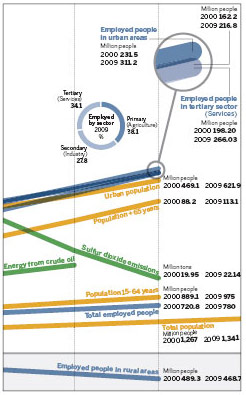

China Daily takes a look back at the 11th Five-Year Plan (2006-2010) and how it was implemented.
Rapid economic growth
In 2010, China surpassed Japan as the world's second-largest economy with GDP reaching 39.8 trillion yuan ($6.1 trillion), a 69.9-percent increase from 2005 after adjusting for inflation.
The average annual growth rate from 2006 to 2010 was 11 percent, far exceeding the target of 7.5 percent set in 2006.
Per capita annual income also grew rapidly. In 2010, urban income reached 19,109 yuan, up 82.1 percent in five years, while rural income was 5,919 yuan, up 81.8 percent.
Employment and an aging population
The population now stands at 1.341 billion, and the number of people with jobs increased from 758 million in 2005 to 780 million at the end of 2009. Challenges lie ahead as the population ages: the number of people in the workforce will decline, and spending on welfare and healthcare will increase.
Economic reconstruction and the service sector
During the 11th Five-Year Plan (2006-2010), focus was given to development of the country's tertiary sector.
The goal was to increase the share that sector contributed to GDP to 43.4 percent in 2010, but the final figure was 43 percent. Work is still required to increase job opportunities in the sector.
Energy saving close to target
China's energy consumption per unit of GDP dropped 19.06%, close to the goal of a 20-percent decrease.
Looking back, looking ahead
Most targets and provisions set in China's 11th Five-Year Plan have been met, and you can find the details below. But the nation still faces great challenges, including its economic reliance on investment and exports, its unbalanced development between urban and rural areas, and a widening wealth gap.
The central government lowered its target for annual GDP growth to 7 percent in its draft of the 12th Five-Year Plan (2011-2015), which is expected to be discussed in the annual session of the National People's Congress, which begins on Saturday. In the new blueprint, attention will be paid to improving people's living standards and to restructuring the economy, upgrading industry, reducing emissions and saving energy. The plan will maintain a strategy of expanding domestic demand and will seek a new model of economic growth that would include a greater contribution by consumption.
China implemented its first Five-Year Plan in 1953. Except for a period of economic adjustment from 1963 to 1965, it has used these plans as blueprints and guidelines for national economic development.
